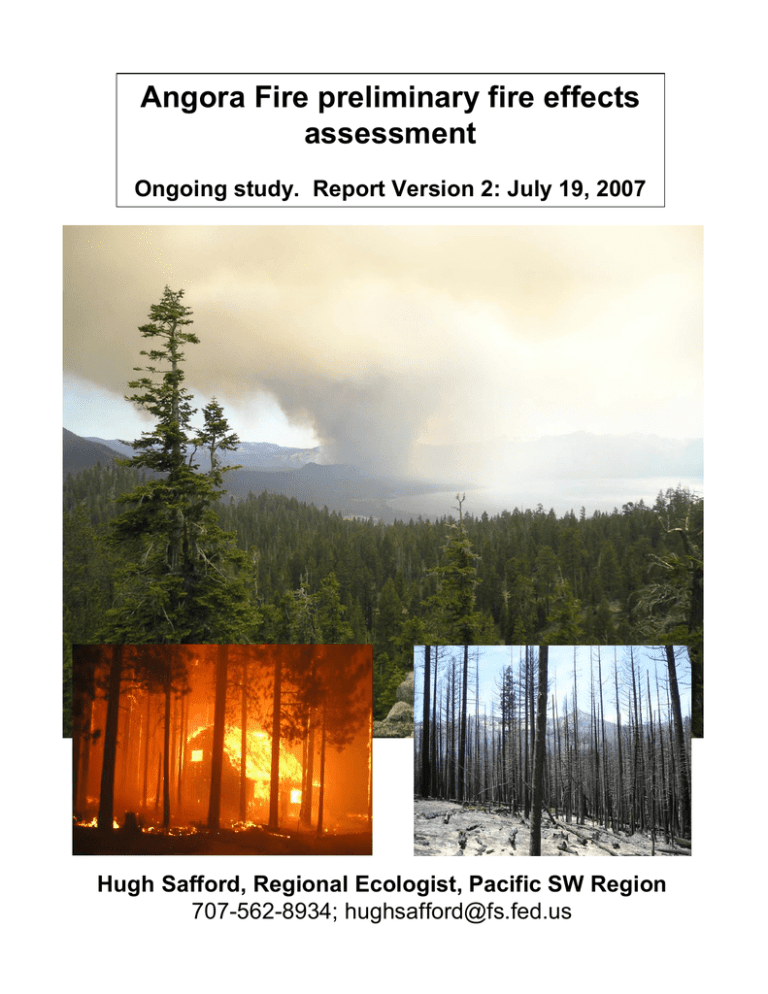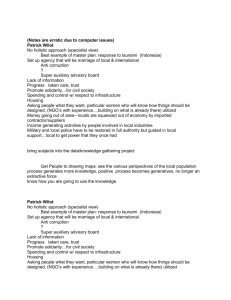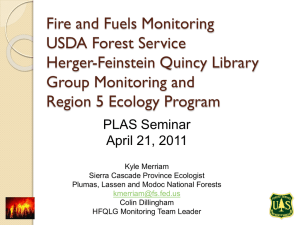Angora Fire preliminary fire effects assessment
advertisement

Angora Fire preliminary fire effects assessment Ongoing study. Report Version 2: July 19, 2007 Hugh Safford, Regional Ecologist, Pacific SW Region 707-562-8934; hughsafford@fs.fed.us 2 Sampling underway Sampling completed 4 Fire perimeter 1 2 3 Untreated Area Jeffrey pine-White firLodgepole pine No fuels treatment Treated Area Jeffrey pine-White fir Thin & salvage 1996-1998 Precommercial thin (hand) 2003-2004 Activity fuels pile burn 2005 Point-center-quarter transects sampled July 8, 18, 19, 2007 Transect length 220 to 500 m, 10-16 sampling pts each, random distance intervals (between 15-45 m). Variables measured: species, dbh, ht, scorch ht, torch ht, bole char ht, % crown scorch, % crown torch 3 Area of Transect 1: no treatment Area of Transect 2: treated for fuels 1996-2005 Angora Fire preliminary fire effects assessment, v.2 (7/19/07) Quantitative comparison of transects, Angora Creek area 25 ca. 370 meters Meters 20 15 ScorchHt CharHt 10 5 Untreated Treated 0 0 1 2 3 4 5 6 7 8 9 10 11 12 13 14 15 16 17 Sampling Point Transect 3 35 ca. 500 meters Untreated 30 Treated 20 ScorchHt CharHt 15 10 5 0 17 Transect 4 16 15 14 13 12 11 10 9 8 7 6 5 4 3 2 1 0 Sampling Point Changes in scorch height and bole char height along the linear courses of Transects 3 and 4 (see map for locations), which sample the transition from untreated to treated forest. The black vertical line represents the approximate boundary of the fuels treatment. Error bars represent +/- one standard error. Meters 25 4 Angora Fire preliminary fire effects assessment, v.2 (7/19/07) Quantitative comparison of transects, Angora Creek area 120 ca. 370 meters Percent of canopy 100 80 % Crown Scorch 60 % Crown Torch 40 20 Untreated Treated 0 0 1 2 3 4 5 6 7 8 9 10 11 12 13 14 15 16 17 Sampling Point Transect 3 120 80 % Crown Scorch % Crown Torch 60 40 20 Untreated Treated 0 17 16 15 14 13 12 11 10 Transect 4 9 8 7 6 5 4 3 2 1 0 Sampling Point Changes in percent crown scorch (needles browned) and percent crown torch (needles combusted) along the linear courses of Transects 3 and 4 (see map for locations). The black vertical line represents the approximate boundary of the fuels treatment. All trees in the untreated portion of Transect 4 exhibited 100% crown scorch. Error bars represent +/- one standard error. Percent of canopy 100 5 Angora Fire preliminary fire effects assessment, v.2 (7/19/07) Quantitative comparison of transects, Angora Creek area 1.00 Proportion surviving fire Untreated Treated 0.75 0.50 0.25 0.00 1 2 3 4 5 6 7 8 9 10 11 12 13 Sampling Point 14 15 16 Transect 3 1.00 Treated 0.75 0.50 0.25 Proportion surviving fire Untreated 0.00 16 15 14 Transect 4 13 12 11 10 9 8 7 6 5 4 3 2 1 Sampling Point Changes in tree survival along the linear courses of Transects 3 and 4 (see map for locations). The black vertical line represents the approximate boundary of the fuels treatment. The Y-axis represents the proportion of sampled trees surviving at each point. No trees survived in the untreated forest sampled along Transect 4. These mortality estimates are based on first-order fire effects only and will likely change as long-term mortality agents (insects, etc.) assert themselves. 6 7 Angora Fire preliminary fire effects assessment, v.2 (7/19/07) Quantitative comparison of transects, Angora Creek area 200 180 160 140 120 100 80 60 40 20 0 t = 1.202, df = 4, P = 0.296* t = 7.624, df = 50, P < 0.0001* t = 5.271, df = 30, P < 0.0001* Stem density (trees/acre) Number of trees >5” dbh (diameter at breast height) per acre Tree cover (%) Tree canopy cover, from LTBMU vegetation map1 Untreated Treated % mortality Percent of trees >5” dbh (diameter at breast height) killed by fire. This is a preliminary estimate based on firstorder fire effects. * t-test. Error bars represent +/- one standard error. 1 Untreated area cover estimated from polygons mapped immediately adjacent to treatments 8 Angora Fire preliminary fire effects assessment, v.2 (7/19/07) Quantitative comparison of transects, Angora Creek area 70 t = 11.942, df = 206, P < 0.0001** 60 50 Z = 10.274, P < 0.0001* Feet Z = 10.955, P < 0.0001* 40 Untreated 30 Treated 20 10 0 Crown torch height Mean height limit of torching (needle combustion) in the tree canopy1 Crown scorch height Bole char height Mean height limit of scorching (needle scorch) in the tree canopy Mean height limit of tree bole (trunk) charring from surface fire2. This is an estimate of surface flame length.3 *Wilcoxson two-sample (nonparametric) test; ** t-test. 1 81% of trees (87/108) in the untreated samples had torching effects to their crowns; only 11% (11/100) of trees sampled in the treated area showed torching effects. Mean torch height of trees in the treated area actually exhibiting torching was 14.4 feet. 2 100% of trees sampled in the untreated area received bole char; 19% of trees (19/100) in the untreated area showed no bole char whatsoever and 36% showed bole char <1.5 feet in height. 3 Usually an overestimate due to bark combustion. 9 Angora Fire preliminary fire effects assessment, v.2 (7/19/07) Quantitative comparison of transects, Angora Creek area 100 90 Z = 9.726, P < 0.0001* 80 Z = 10.338, P < 0.0001* Percent 70 60 Untreated 50 Treated 40 30 20 10 0 % Crown scorch Mean percent of tree crown scorched by fire (needles browned) % Crown torch Mean percent of tree crown burned by fire (needles combusted)1. 41% of trees (44/108) sampled in the untreated area had >90% crown combustion * Wilcoxson two-sample (nonparametric) test; error bars are +/- one standard error 1 Of the 11 trees in the treated area exhibited crown torching, mean % crown torch was 25.1% (median = 12.5%). 10 Angora Fire preliminary fire effects assessment, Version 2 (7/19/07) Summary Angora fuels treatments 1996-2005: 1. Fuels treatments significantly reduced tree canopy continuity and surface fuels (surface fuels data collection underway) in the area adjacent to the Tahoe Paradise subdivision 2. Fuels treatments significantly decreased tree mortality • Tree mortality based on first-order estimates was about 77% in untreated areas, about 21% in treated areas 3. Fuels treatments significantly lowered flame lengths and reduced the effects of fire to the tree canopy • 100% of trees in the untreated sample had torching effects to their crown, vs. about 11% in the treated sample • The vertical extent of crown torching, crown scorching, and bole char was much greater in the untreated area • Surface flame lengths (as estimated by bole char) averaged more than 32 feet in the untreated area, compared to about 7.5 feet in the treated area • Within the untreated sample area, crowns in most trees were completely scorched, and more than 40% of trees had >90% of their crowns combusted by fire 4. Fuels treatments in the Angora Creek area significantly changed fire behavior, reduced fire effects to the ecosystem, and acted to slow and ameliorate the intensity of the fire as it approached homes in the Tahoe Paradise subdivision





